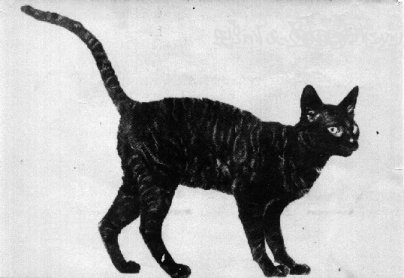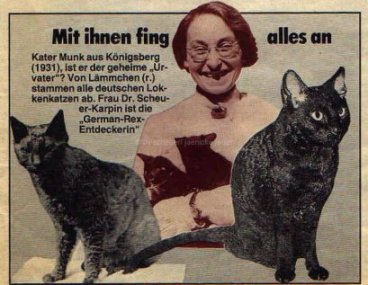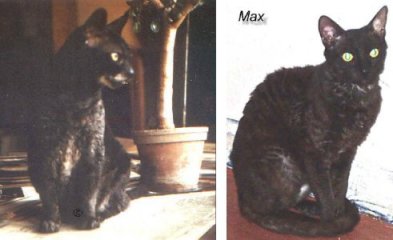The revival of the German Rex
By Tony Batchelor, Snugglebugs, Denmark.
(Reprinted with permission)
First I will tell the story from the earliest days to the present. I will then add an appendix that attempts to summarise the known facts regarding the mutation that started the breed, together with some speculations of my own about the later genetic inheritance.
 The story of the German Rex as a recognised breed began when a kitten was born in Berlin to otherwise normal house cats. That was in 1947. That black female kitten had a curly coat and was left to wander freely with no particular notice being taken of her appearance. She seems to have needed to find herself a home, and was eventually adopted by nurses working at the Berlin Hufeland hospital. Now, almost sixty years later, the story seems to have come full circle with another stray Berlin cat becoming part of the revival of the breed. This modern addition to the story is a recent addendum to my appendix.
The story of the German Rex as a recognised breed began when a kitten was born in Berlin to otherwise normal house cats. That was in 1947. That black female kitten had a curly coat and was left to wander freely with no particular notice being taken of her appearance. She seems to have needed to find herself a home, and was eventually adopted by nurses working at the Berlin Hufeland hospital. Now, almost sixty years later, the story seems to have come full circle with another stray Berlin cat becoming part of the revival of the breed. This modern addition to the story is a recent addendum to my appendix.
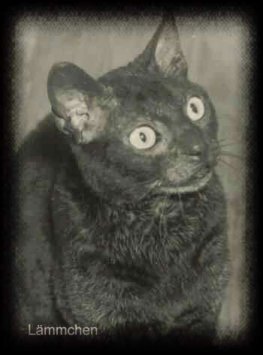 In the summer of 1951 a doctor, Dr Rose Scheur-Karpin, noticed in the hospital garden, that black, curly coated, cat. The doctor adopted her and named the cat Lämmchen (German for little lamb). Her supposition that she must be the result of a mutation, was later shown to be correct as the result of some studies done in Britain in 1956 that compared Lämmchen to another curly-coated breed that was discovered in Cornwall in 1950. Thus Lämmchen was in fact the first breeder-owned rex-type cat and the maternal ancestor of all the German Rex cats. Just for accuracy, I must mention that another "German Rex" was reported in 1931, not far from Berlin, but no breeder was ever known to have been involved. It is interesting now to speculate that Lämmchen may have been descended from him!
In the summer of 1951 a doctor, Dr Rose Scheur-Karpin, noticed in the hospital garden, that black, curly coated, cat. The doctor adopted her and named the cat Lämmchen (German for little lamb). Her supposition that she must be the result of a mutation, was later shown to be correct as the result of some studies done in Britain in 1956 that compared Lämmchen to another curly-coated breed that was discovered in Cornwall in 1950. Thus Lämmchen was in fact the first breeder-owned rex-type cat and the maternal ancestor of all the German Rex cats. Just for accuracy, I must mention that another "German Rex" was reported in 1931, not far from Berlin, but no breeder was ever known to have been involved. It is interesting now to speculate that Lämmchen may have been descended from him!
Lämmchen had many kittens but most are unaccounted for prior to Rose adopting her. Even her later ones are largely untraceable, but I can account for about 60 from notes made by Rose. Whether or not any were sterilised cannot be known for certain, so the conclusion must be that there are still domestic cats in and around Berlin that carry Lämmchen's inheritance to this day! See addendum
Various breeders in East Germany (as it then was) took curly-coated kittens from Rose and between them they were successful in breeding more German Rex. By 1957 a kitten had already been sent to a British breeder, but unfortunately it died soon after arrival. In 1960 others went to Paris but due to mistakes by the airline, the cats died on the way. Later that year there was better success and one cat was shown in public outside East Germany. Finally, in 1961, cats went to the USA where some enthusiastic breeders got together there and produced many cats that became well known in GRX pedigrees. The records of Lämmchen's offspring continue up to 1962 when she had her last. Lämmchen died in 1964, and by 1968, there were only three direct descendents of Lämmchen known.
After 1968 all seemed to be well for the breed as in later years both European and American breeders produced many good cats, and obtained recognition for the breed in their respective cat breeder organisations.
Going back a few years, it is only thanks to the Barensfeld family (breeders in Grund in East Berlin) that the few wonderful German pedigree cats were protected. The three known animals from that breeder were Ferdi, Roland and Silke von Grund. In the beginning the Barensfeld family knew nothing of the new Rex mutations in England, or of the crossed Devon Rex in the breed that arose from early genetic experiments that mistakenly assumed that there was only one rex mutation.
Up to now the old breeders of the GDR are always forgotten in the published stories although in the early days they played a major part. The first registered GRX breeder was Mr. Barensfeld (and judge in the GDR) who received the first GRX from Mrs. Gertraute Knuth (nurse in the Hufeland Hospital at Berlin-Buch, a colleague of Dr. Rose Scheur-Karpin). There was also the family Kania (cattery: vom Jagdrain) and Thomas Hamann (cattery vom Hause Hamann since 1985) who both had a large portion of the GRX breed in the former East Germany. The Woellner family received their first GRX from Mr. Barensfeld. With the breakdown of the barriers between the two Germanys in 1989/90, the way was open to better development of the breed. This did not turn out quite as anticipated!
|
Christopher Columbus, 1961 |
Earlier in the USA the breeders there attracted a lot of attention initially, but somewhere along the way the impetus died out. Amongst other things that happened was the production of a new cat magazine called The Forum that featured the GRX in articles as early as 1971. But despite all that happened in the 1960's, by 1970 the record stops with the last known American kittens born and soon breeding seems to have stopped altogether. As an indication of the decline in the breeds fortunes in America, in 2005 the American Cat Fancy Association (CFA) did not even have a record in their office that the GRX had been recognised by them and registered there!
Generally the breed had poor penetration against the other curly breeds. In the last decade the GRX breeders would have succumbed if it had not been for the efforts of the Swiss breeder Fru Schwarzenbach (as Frizzled Frolic) who took the initiative to revive the breed. This is how it happened.
By 1999 there were only two fertile German Rex females known in the world, Batu Happy von Quiomme and Bonsai the Frizzled Frolic - there were no tomcats! The situation was apparently saved when a response to an advertisement searching for any fertiles was received in 2000, from a cat rescue centre. They said that they had two cats, and knew of a breeder who was giving up who had others and suddenly decided to give all his cats to any breeders who could take them! The situation appeared to be saved!
Then the situation became, if anything, even worse. When the cat rescue people (who were brought in again by that breeder) tried to collect the cats a fertile male panicked, hit its head and had to be destroyed. A female (Gretel) was pregnant and the foetuses died. To save Gretel she had to be sterilised. The remaining cats were so little used to human company or were sick so that they died soon after the rescue attempt - the end result, a lot of heartache and a few pet cats.
Then the situation deteriorated further in 2000 as Happy herself had problems. Born in 1997 she was received in June 2000 in a not very good condition; disturbed and with a uterus- inflammation. It was even more essential that she was mated before she became so bad that she would have to be sterilised to save her life. Mating should succeed and would probably help to clear up the inflammation. A decision was made by her owner and the few breeders still wanting to be involved to find a stud of another breed, and in a hurry! Available was an Abyssinian. This was suggested and accepted after further consultation, as it would give the correct type, if successful. Let me quote from a letter I have that told the story in the owner's own words - 'It functioned. The first hybrids were received with joy. All wanted at that time!!! But I did not have relations with a breed committee, that approves this mating.'
To keep the breed active the decision was taken to register the kittens as if they had a housecat as a father, and thus "Maximillian" was created. Again I quote - '"Maximillian" was a creation ;-) I would have never got the permission from her club to mate Happy to my Abyssinian "Puschkin". So we created the cat "Maximillian" a black-ticked housecat.'
|
Dr. Rose, Kater Munk, Lämmchen and kittens |
Matters were left as they were for a few years until the four hybrid offspring from that mating had themselves been mated. It was the only mating from "Maximillian" as he died in September 2000. In 2001 Bonsai was mated to one of Happy's offspring, Boogie Curlyhead vom Batu, and produced one GRX kitten. In addition there was a female who was only a few months old in 2000, Chuba Chups the Frizzled Frolic. She was also mated to Boogie in 2001 and that also produced one GRX kitten. Thus the revival started with Happy and Puschkin and continued with Bonsai.
So that is how I found the pedigree information when I got my first German Rex in 2004, and at the same time became the GRX database maintainer for PawPeds. However, in April 2005, Happy's owner decided that it was necessary to correct the pedigree record and contacted the DEKZV registrar to put their records straight. The DEKZV breed committee agreed that the circumstances in 2000 had been so unusual that they could retroactively approve the mating, and thus "Maximillian" was revealed in his true identity as Segena's Puschkin, a ABY n, born in 1993.
In this story I have not included all the names of those involved, as it is sometimes difficult to be sure of getting them all. So rather than offend by including some names and not others, I have just mentioned those people well known in the historical record.
(Not so well known is that in this frequently used illustration, Rose and Lämmchen could never have met Kater Munk!)
© Tony Batchelor, February 2006, Odense
Appendix - May 2005
Is the genetic structure of the modern GRX as good as it should be?
Just how much of Lämmchen's inheritance is in the modern cat? For example, Evelyna, my six months old cat has Lämmchen appear just five times in her pedigree, in the ninth and tenth generations, but over the same time span, there are eleven CRX appearances. (These figures currently based on the present stage of the GRX database.)
Just a few odd thoughts to connect some facts:
In the history of rexed cats, there have been three main types accepted and bred by the cat fancy in the 20th century. There have been others, but they are a minority and mostly later. There are also differences such as the Selkirk in which the mutated gene is a dominant and not a recessive.
In the various descriptions of the rexes, it has been common practice to distinguish the mutations by naming them Gene 1 and Gene 2. I wonder if in fact that is sufficient to adequately describe all of the modern rexes? For example, in the rabbit there are at least three, only one of which has wavy fur.
I will start with a brief history of each from the standpoint of the genetic structure. Of course, I am not a geneticist, so my point of view is merely to correlate the writings of other authors, together with some logical deductions of my own.
It is apparent that there have been "curly cat" mutations in much earlier times than the cat fancy has recognised them! Even in the older books that first mentioned the two English rexes, authors recall even earlier stories of "children cuddling curly coated kittens". This is similar to another well-known coat mutation; that of the Sphynx. In that breed we even have photographic evidence from 1902 that so-called hairless cats are viable, and that is from the south of North America, whereas the 1960's foundation cats came from similar mutations thousands of km away in the cold north!
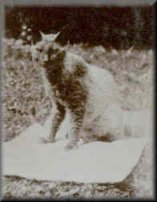 The first reported rex mutation in the cat appears to be from the 1930's (1930/1) in Prussian Germany from Konningsberg (now in Russia). Luckily photos of Kater Munk exist, although there does not seem to have been either any useful reporting, investigation or attempted or even any known but accidental breeding from him. The later rexes in Germany were reported from places far distant, at least in cat terms, at Berlin, Essen and Siegburg. It is therefore statistically improbable that they were identical mutations.
The first reported rex mutation in the cat appears to be from the 1930's (1930/1) in Prussian Germany from Konningsberg (now in Russia). Luckily photos of Kater Munk exist, although there does not seem to have been either any useful reporting, investigation or attempted or even any known but accidental breeding from him. The later rexes in Germany were reported from places far distant, at least in cat terms, at Berlin, Essen and Siegburg. It is therefore statistically improbable that they were identical mutations.
The second reported rex mutation in the cat is better documented and was in the county of Cornwall in the southwest of England. That was in 1950. Research by Jude and others at the time proved that a recessive gene carries this mutation, and they later termed it Gene 1. For reasons that will become apparent later, I term it gene cr from the name given to the breed, Cornish Rex.
The third reported rex mutation in the cat was again well documented by Jude and his later co-researcher and author, Searle. This cat, Lämmchen, was near Berlin in Germany, which is over 550km distant from Konningsberg. A decade later, experimental breeding showed that the new cat did not have any compatibility with the Devon Rex. However, earlier breeding with the Cornish Rex did result in further rexes. It was therefore assumed (my emphasis) that the gene mutation was the same, although it was not possible at the time to test this by actual gene inspection - for example by DNA tests - so I will give it another name, gene gr from the name, German Rex. As far as I am aware, there has still been no confirmation by DNA analysis.
The fourth reported rex mutation in the cat was also well documented (and created great interest amongst the breeders and researchers) and was in the county of Devon that borders Cornwall. As the two nearest towns are 80km apart, again it was thought unlikely, purely from the statistical point of view, that there was any connection. As it soon became clear that breeding this type of cat together with either of the other two did not produce more rexes, that lack of any connection was proved. The name given was Gene 2, but I will be using the name gene dr from the name, Devon Rex.
The fifth (and sixth) reported rex mutation in the cat is comparatively recent, appears to have happened twice, and is not so well documented. They were both from Lanzarote in the Canaries - one in about 1981 and one in 2000. The nineteen years separating the two cats does not apparently give any direct connection, which could have been expected if they were descended from an import! Therefore I have to consider these as two more mutations and will give them the names gene lr and gene lr2 from Lanzarote.
The seventh reported rex mutation in the cat (Preuss from Siegburg) was a little earlier than my fifth and sixth above, in 1979, but I do not consider this cat relevant to the other mutations for the reason that mating to another GRX type only produced two straight haired kittens. Those two kittens were subsequently mated with each other and produced one cat described as a GRX, but I consider that pedigree to be rather suspect. If the mutation was genuine, then it could be called gene sr. Incidentally, one distance involved is comparatively short in our terms, but not perhaps, from a cat's viewpoint! Siegburg is only about 100km from Essen, but 470km from Berlin.
Further work needs to be undertaken to establish if any part at all of Lämmchen's genetic inheritance is left in the modern breed! My reasons for putting this question are as follows:
- From the above, it is known that there have been three additional mutations that appear to give German Rex cats. I define the "real" German Rex as only those cats that have the gene type I have designated gene gr.
- I believe that there is no actual proof that her gene is any longer in the GRX gene pool.
- Statistically, I would consider that it is more likely that the modern GRX type cat is merely a gene cr coated cat with a DOM body structure (but, see my appendix).
- It is necessary to take in to consideration the fact that individual gene mutations at the same locus need not be of the same gene to give similar effects on later generations.
How can this supposition be tested? There seems to me to be two possibilities.
- In 1956 Searle and Jude investigated rexing in the cat. At that date they only knew of two types that they called the English and the German. We now know them as CRX and GRX. In their research they compared hair samples from a CRX (cat not stated) and from Lämmchen. Thus a similar comparison of modern cats with their 1956 microscope derived drawings might well yield valuable information.
- More accurate, but also more difficult, would be a full investigation leading to an analysis of the genetic structure itself - a "DNA test".
Tentative conclusion:
Until some physical research is possible to prove matters one way or the other, I propose that it is necessary to conclude that the modern GRX is unlikely to have evolved from the gene type gene gr but from the gene type gene cr to control the coat and various DOM cats that simulate the body structure of the early GRX. But, see my recent addendum.
If that conclusion is not correct, then great care is necessary to avoid the introduction of even more of the gene type gene cr, and instead breed for greater penetration of the correct gene type gene gr. (Referring to my addendum, this may be about to happen!)
However, if that conclusion is correct, then it has to be acknowledged and breeding plans modified accordingly as soon as is possible.
In either case, it is important that very careful thought is given to the updating of the GRX Standard.
Tony Batchelor, May 2005, Odense
Addendum March 2006
Shortly after writing the above in 2005, a hitherto unknown breeder contacted the GRXCC for advice on homing two litters of German Rex!!! The cattery is Moorteich and is in Stralsund, northeast Germany, about 250km from Berlin. On the face of it, a long 'cat distance' which implies another mutation? However, it soon became clear that this introduction could mean a lot more than that, as follows:
|
Lämmchen (left) and Max (right) |
The mother of the last litter is a GRX called Diana who was bred from well-known lines. The father, Max, is also a full GRX, and his parents, grandparents and some great grandparents are known. All six kittens in the litter (Moorteich's G litter) are now registered as GRX and they will be used by some existing GRX breeders as potential parents.
Using my originally outlined suggestions, the possibility that Max is yet another mutation immediately came to mind, until more information emerged only a few days ago. Max was bought through an advertisement offering Max for sale in Berlin.
Max's grandmother on his father's side, and his great grandmother on his mother's side, is Pumina. Pumina was a black curly-coated cat found on a construction site in the Wedding quarter of Berlin. After changing hands three times, she was homed elsewhere in Berlin where she had a last litter. She was born in 1993, and although only living for two years, in that time she had several litters, nearly all of which were not curly. Where most of those kittens went is not known, but inbreeding of five of the kittens (natural, not planned!) eventually ended up with a litter of Max and his sister who was not curly.
The Hufeland Hospital where Lämmchen was found has since been relocated, but the buildings are still there at Karower Strasse 11. Pumina was found only 14km away.
Now we would appear to have a very good possibility that Max is in fact a descendant of one of the many Lämmchen kittens that were spread so widely around Berlin in the 1950's and 60's. More research will now be attempted into Max's background to see if he might carry the genuine gene gr. Is Lämmchen here seen looking at her descendant of almost 60 years later?
Tony Batchelor, April 2006, Odense

